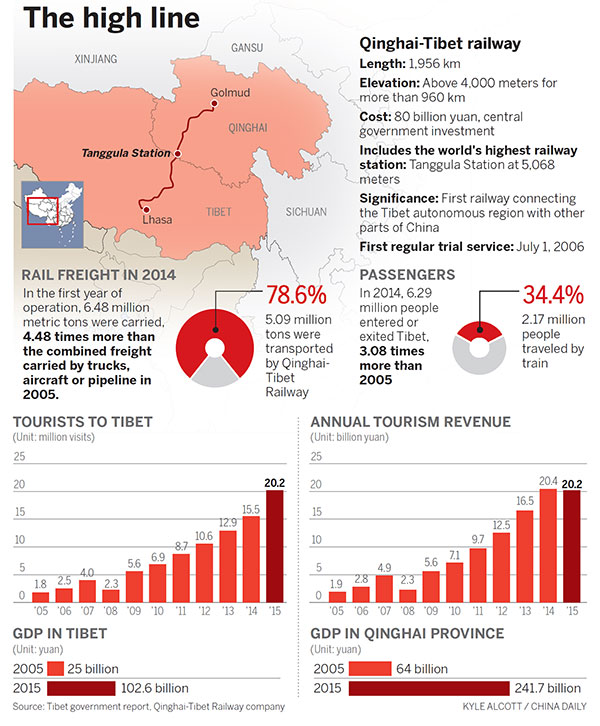Speed, economy combine to benefit millions since world's highest train line was constructed

About 1,375 years ago, Wen Cheng, a Han princess of the Tang Dynasty (AD 618-907), took nearly three years to travel the 2,800 kilometers from today's Xi'an, Shaanxi province, to Lhasa, Tibet, to marry Songtsan Gampo, the Tibetan king.
Now, thanks to the opening of the Qinghai-Tibet Railway 10 years ago, the trip takes just 32 hours.
People across the country have enjoyed the modern benefits of speed and economy. Zhou Heng, 25, can reach his fiancee in Lhasa in less than four days from his hometown in Dalian, Liaoning province.
"The train is cheaper than flying," said Zhou. "I saw her five times last year. I flew once and took the train once. She came by train to see me three times in Dalian. We can't afford frequent flights."
A train ticket from Beijing to Lhasa ranges from 360 to 1,144 yuan ($54-$172) depending on seat choice. A flight can cost more than 2,000 yuan.
Friday was the 10th anniversary of the opening of the Qinghai-Tibet Railway. Over the past decade, millions of people like Zhou have benefited.
Qinghai province native Chungdak Tsering, 30, is one of the many. "My grandmother is thrilled about the train because it allows her to visit temples in Lhasa and other cities in Tibet easily," he said. "My grandmother is 80 years old. We worried about her health because it took several days to travel to Lhasa in the past. Now she can sleep well on the train, and it takes only one day to reach Lhasa."
His grandmother visits Lhasa every second year now.
The railway is 1,956 kilometers long. At its highest point, it is 5,072 meters above sea level. It is the world's highest line, and the longest built on a single plateau. It is the first railway connecting Tibet with the rest of world.
The railway links Xining, the capital of Qinghai province, to Lhasa, capital of the Tibet autonomous region.
According to the China Railway Corp, the Qinghai-Tibet Railway had carried 115 million passengers and moved 448 million tons of goods as of May.
Tourism surged as visitors to the region exceeded 20 million, creating job opportunities and bringing 28 billion yuan in revenue for local herders and farmers along the line, according to Losang Gyaltsan, chairman of Tibet.
"The railway has greatly improved locals' lives and helped transform the local economy," he said.
Ji Guogang, director of the region's Development and Reform Commission, said, "The railway has boosted Tibet's economic and social development. Tibet's annual GDP growth remains over 10 percent."
GDP surged from 25 billion yuan in 2005 to 102.6 billion yuan in 2015. The Qinghai economy also rose, from 64 billion yuan in 2005 to 241.7 billion yuan last year.
The Qinghai-Tibet Railway has 18 loading stations in industrial zones and at coal bases, with trains carrying industrial salt, fertilizer, alkali, coal, aluminum and iron ore from the Tibet Plateau.
Five more stations in a rail section from Golmud, Qinghai province, to Lhasa are under construction, and six other stations will be renovated.
Apart from the Qinghai-Tibet Railway, other railway lines have opened or are planned on the plateau, including one connecting Lhasa to Xigaze in Tibet to Nyingchi, Sichuan province.
To the west, planned lines will link Jilong in Xigaze prefecture with neighboring Nepal via Yadong, a town near the Nathu La mountain pass.
Next: First person account of a police chief on trains running along the railway
